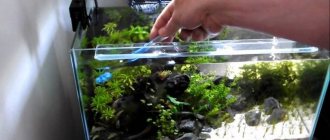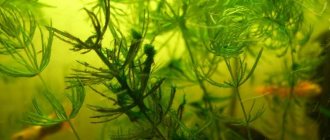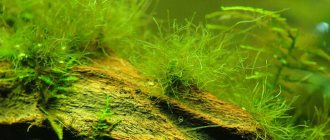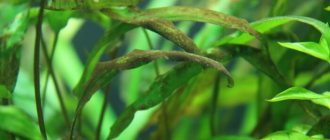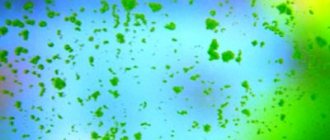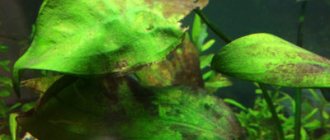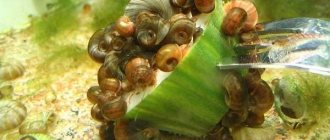The appearance of a green coating on the walls of the aquarium indicates an imbalance in the ecosystem of the home pond. Contamination of the walls is not only an aesthetic problem. Excessive development of algae can pose a serious threat to all inhabitants, so getting rid of greenery in the aquarium is the first priority of its owner. Algae are an integral part of the natural microflora of the tank, but their excessive development of green plaque begins when the conditions of detention are violated.
Signs
Signs of ecosystem disturbance:
- cloudiness of water;
- change in color of the liquid to green and brown;
- the scenery, water surface and soil are covered with a green film or coating;
- increased content of phosphorus and nitrates;
- abundant appearance of green plaque in the aquarium.
Plaque in small quantities is considered normal. Don't be alarmed if you notice a few green dots in your aquarium. Observe the flora; if the glass becomes more green and the water becomes cloudy, this should be a cause for concern.
How to clean algae and plaque from artificial aquarium plants and decorations
Beginners love artificial aquarium plants and decorations.
They think that they are easier to use than living plants. I assume that you have already become convinced of the incorrectness of this statement personally, since you are reading this article.
Artificial plants in an aquarium are also susceptible to overgrowing with algae and plaque, with the only difference from living ones.
Plaque and algae do not harm artificial plants or decorations, but they do detract from their appearance.
It's just a matter of time before you need to clean them.
Never clean plastic or silk plants or decorations with toxic cleaners without rinsing thoroughly under running water.
By placing well-cleaned but poorly washed decorations and plants, you will see the rapid death of fish in the aquarium.
And the smaller the aquarium, the more fatal the consequences of poorly washed decorations and artificial plants.
Now that I've scared you a little, I can move on to describing the process.
What is needed for cleaning
To clean the aquarium you need cleaning equipment:
Clean your aquarium once a week. Cleaning is carried out in 8 stages:
About algae
Diatoms, or diatoms (Bacillariophyta) are a large class of lower plants that are widely represented on our planet. Both marine and freshwater species are found. They play an important biological role in nature, as they are an important component of phytoplankton and a source of food for many aquatic inhabitants.
Diatoms are exclusively single-celled organisms. Their size is 0.75-1500 microns. Their main feature is the presence of an outer hard shell, which is a porous shell of silica. It consists of two halves that fit into one another. During the process of reproduction, each new cell receives only one half of the shell, and it completes the second half itself. Thus, with each new generation, the size of the plants decreases. Most often in the aquarium you can find representatives of the genus Navicula, Pinnilaria and Cymbella.
Despite their great importance in nature, these algae are undesirable in the aquarium. The brown coating they form greatly spoils the aesthetic perception of the aquarium. Diatoms are not dangerous for fish; in the initial stages of development, they also do not cause serious harm to plants. They are easily erased from glass, decorations and plant leaves. A characteristic feature is that diatoms produce dust - if you run your fingers over the deposit, a small cloudy cloud will rise in the water.
In case of rapid development of algae, the plaque becomes black due to the constant build-up of layers on top of each other. In this case, the bottom layer of plaque becomes difficult to remove. It seems that the leaves are sprinkled with earth or black sand. At this stage, diatoms already become dangerous for living plants, because a dense coating on the leaves reduces the efficiency of the most important process for plant life - photosynthesis, which ultimately can lead to the death of the plant. Diatoms spread so quickly that new leaves are instantly affected by them. In addition, diatoms create an excellent “springboard” for the establishment of other difficult-to-remove algae, such as “blackbeard”.
In herbal aquariums, diatoms are very rarely present, since higher plants absorb all the nutrients from the water and there is simply nothing for algae to feed on. Therefore, their main domain is newly started aquariums with low (or no) lighting and artificial decorations, or established aquariums that have been left without proper care.
How to get rid of greens in an aquarium
The use of cleansing agents is a last resort. First of all, change the living conditions of the aquarium inhabitants:
Inhabitants that help fight plaque:
Safely cleaning aquarium plants and decorations with bleach
Very often, aquarists use chlorine bleach to remove stubborn plaque, dirt and algae.
- Mix 1 part bleach and 9 parts clean water to make a 10% solution
- Soak decorations or artificial plants in the solution for 15 minutes
- After the bleach solution, place the decorations in plain water for 15 minutes
- Rinse thoroughly in running water
Any chlorine bleach, like the famous “Whiteness,” is suitable for this.
Chlorine bleach can partially discolor artificial aquarium plants, which indicates a low quality product.
High-quality plastic aquarium plants are coated with a special varnish that easily withstands the effects of chlorine bleach.
Do not mix bleach with other cleaning products to create a more caustic mixture.
Before washing in water, you can use a chlorine neutralizer.
Causes
The appearance of plaque is caused by improper maintenance of the aquarium and disruption of its biological environment. Algae that creates a green coating on the walls of the aquarium:
Thermal mode
Elevated temperatures have a beneficial effect on the development of weeds. Make sure that the lamp does not heat the water too much, and in the warm season, be especially attentive to the temperature regime.
In warm water, oxygen spreads less well, chemical reactions proceed faster, stimulating the release of nitrates into the water. These substances provide food for green weeds.
Light mode
Avoid direct sunlight on the walls of the vessel. The amount and spectrum of light plays a role. In summer, daylight hours do not exceed 12 hours, in winter – 7. The walls of the aquarium turn green from the intense light of the yellow spectrum.
Large amount of feed
The food that is not removed from the bottom becomes food for the lower greens. Remove excess feed with a siphon or net.
Human waste
Together with uneaten food, waste products create conditions for the proliferation of green algae and poison the water with ammonia and nitrates.
The most common problems when maintaining an aquarium
Every underwater lover in the room has had to deal with aquarium cleanliness issues at one time or another.
The most common problems.
- Cloudy water . The water loses its transparency and acquires a whitish tint. Most often this happens in a new aquarium that has just been stocked with fish. This phenomenon is temporary. The development of a mass of bacteria makes the water opaque. This continues for two to three days. With proper feeding of the fish and optimal temperature conditions, the next stage in the formation of the underwater world begins - the biological balance between single-celled organisms and more highly organized ones. The infusorial haze disappears.
- Rotting in the ground . After some time, the soil may become covered with a dark film and periodically release bubbles. Rotting occurs of organic residues that entered the soil initially or during the process of feeding the fish. To prevent this from happening, it is better to underfeed your pets than to overfeed them. An additional means of combating organic matter in the soil are snails.
- Changing the color of the water to green or brown . This happens due to the development of algae in the water: green, blue-green or brown.
- Plaque formation on the walls . The plaque can also be green or brown.
These two problems are interrelated, often have common causes, and the means to eliminate them are also the same. Plaque on the walls is the biggest nuisance in the life of an aquarium.
If greenery constantly appears
The reasons for the appearance of green plaque are also:
Additional means are:
Discussion on the forum about the problem of lower algae
The main objectives of effective algae control are prevention, detection and eradication.
Algae need three things to reproduce and feed, namely water, light and nutrients. If the aquarium has all three of these points, then it contains algae.
There are many different factors that can cause explosive growth and huge populations of algae. Many aquarists blame this on excessive lighting, but in reality it is an excess of nutrients. Algae are photosynthetic plants and, in addition to light, use nitrates and phosphates for growth. As nitrates and phosphates accumulate in saltwater aquariums, they lead to unwanted (but preventable) algae growth.
There are three simple ways to avoid nitrate and phosphate buildup:
- Add as much feed as residents can consume during the day, and feed additives with caution
- Increase water changes and their frequency.
- Various filter materials that can be used to remove nitrates and phosphates.
Another way to minimize the chances of protozoan algae growth is to add some types of higher algae to the aquarium.
One of the most common of the nuisance species is filamentous green algae, or more simply called filament algae. They can grow in small patches in certain areas or in large grassy mats covering all surfaces. Luckily, string algae is one of the easiest algae to eliminate. Thread is eaten by numerous fish, snails, crustaceans, numerous species of hermit crabs, nudibranchs (sea hares), and sea urchins. Among the fish, blennies (Salarias Fasciatus) and some species of tangs do a good job of eliminating filamentous algae.
If there is too much filament algae in a saltwater aquarium and natural methods do not cope with the task, then the thread should be removed mechanically, while removing excess nutrients in the marine aquarium.
Another commonly found type of lower algae is Valonia spp. This type of algae resembles smooth and shiny green or red bubbles in appearance. The bubbles can be as small as a grain of sand or as large as a ping pong ball. This type of algae is very easy to detect and eliminate.
One of the easiest ways to avoid problems with them is to visually check for new bubbles. When found, regardless of size, carefully remove them with your hands or tweezers, avoiding popping the bubbles, which could release spores. Emerald crabs (Mithraculus sculptus) are known to eat bubble algae.
However, when eaten, they contribute to the release of spores, which threatens new appearances of these algae in the marine aquarium. Thus, relying only on the help of emerald crabs will not solve the problem.
The most difficult algae to eliminate are Bryopsis pennata and Bryopsis plumosa. B. pennata and B. plumosa are green, feathery in appearance and grow on live rock and sand.
An effective way to remove Bryopsis inside an aquarium is to increase the magnesium level by 100ppm daily for 3-4 days, while keeping it elevated for several days. A lesser known method that works well to remove this type of algae is to directly target the briopsis with pure liquid magnesium using a syringe.
Before the procedure, make sure that all flow pumps and pumps are turned off. When using this method, make sure that the magnesium coats the bryopsis from bottom to top. After 5-10 minutes, turn on the flow pumps and other equipment again. After a few hours, there will be a noticeable change in the color of the algae and after a couple of days their complete disappearance will follow. Brightwell Magnesion is well suited for these purposes.
Important! Use this method with caution to avoid sudden increases in magnesium levels in a saltwater aquarium. Also, try not to get pure magnesium on the corals.
Original source: Reefhobbyistmagazine
Translated for
Adviсe
To maintain the biobalance of the reservoir and proper cleaning, follow the recommendations:
- Do not use kitchen sponges or scrapers that have come into contact with detergents to clean the aquarium. Residues are dangerous for fish.
- If it is not possible to turn on and off the aquarium light at a certain time, time relays come to the rescue, which automate the change of day and night in the aquarium.
- It is better not to use metal scrapers and blades, as they leave scratches on the walls of the aquarium. Instead of a scraper, use a plastic card and thin wooden spatulas.
- If you cannot get rid of plaque on stones and decorations, soak them in bleach for 15 minutes, then pour boiling water over them.
- Avoid soil contamination due to overfeeding fish. The poured food is eaten in 5 minutes.
Under natural conditions, the water is saturated with green algae. Aquatic inhabitants eat lower plants. For herbivorous fish, greens are the basis of the diet, for others it is a necessary addition. Algae serve as a habitat for small crustaceans.
(Visited 749 times, 1 visits today)
Where does the green coating come from inside the aquarium?
Plaque on surfaces inside the aquarium is the rapid development of unicellular algae of certain species. Like all plants, they need to live:
- light, preferably a special spectrum close to the sun, like special aquarium lamps;
- carbon dioxide, which they convert into oxygen, obtaining organic matter for their growth;
- mineral and organic substances, which can be conventionally called “fertilizers”. In an aquarium, they are formed from waste products of fish and shellfish, the decomposition of food not eaten by fish, and the rotting of aquatic plants.
Preparing to clean the aquarium
What you will need - cleaning tools
Of course, to clean an aquarium you need the appropriate equipment. Nowadays there is a huge selection in pet stores. I recommend that if you are a beginner aquarist, do not chase expensive fancy accessories, but purchase tools that are easy to use.
First, you will need a siphon to clean the soil from waste and change the water. A siphon is a hollow cylinder with a hose. The siphon scoops up the soil, the water flows through the hose into a bucket, while the soil remains in the aquarium, and lighter weight waste with water is removed from the aquarium. How will water flow from the aquarium into the bucket? Let's remember physics: if you scoop up water with a cylinder and lower the hose into a bucket, and then quickly immerse the entire cylinder in water, the water itself will flow into the bucket. But there are also special pears for this process that are sold in pet stores.
A scraper is also needed to clean glass. There are different types of scrapers: there are ones with a foam sponge, they can even clean plexiglass, which is easy to scratch, and remove easily washed off dirt; there are ones with a rubber nozzle, which, in my opinion, are not very convenient. Scrapers with a blade attachment are good at cleaning glass from stubborn dirt. Using a magnetic scraper, you can clean the walls of the aquarium from loose deposits without getting your hands wet. To do this, the light, floating part of the scraper with the soft side is immersed in the aquarium, and the other part, with a powerful magnet, remains outside - on the glass and, by moving it, you can clean the wall of the aquarium from the inside. The most convenient are scrapers with one handle and interchangeable attachments - for example, a blade, a sponge and a triangular attachment for cleaning the corners of the aquarium.
Of course, the water needs to be drained somewhere, so you will also need a bucket. Since you will need to fill the bucket with water, it is better to allocate a bucket specifically for cleaning the aquarium and not use it for anything else.
Do-it-yourself aquarium cleaning: how and why to clean a home aquarium
Cleaning an aquarium – why is it needed at all?
As many people think: I bought an aquarium, filled it with soil, stuck in plants, artificial or real, threw in a couple of shells or a snag, planted the fish and that’s it, the job is done, all that remains is to feed the fish and occasionally add water. But in practice, everything turns out to be completely different. Well, for starters, the described option for starting an aquarium is, to put it mildly, incorrect and will not lead to anything good, but that’s not what we’re talking about now. Let's say you started the aquarium correctly, gradually added fish, the water in your aquarium is clean and clear, the fish are cheerful and cheerful, and the aquarium is pleasing to the eye. What to do next? This is what will be discussed below.
We will consider the following questions:
